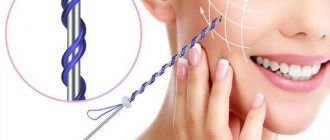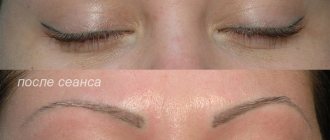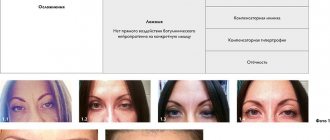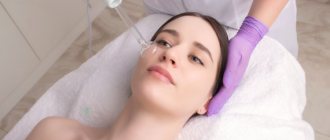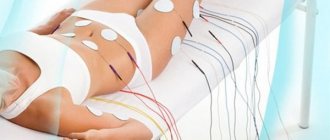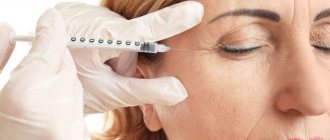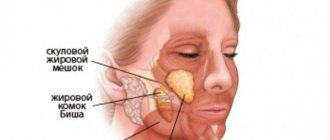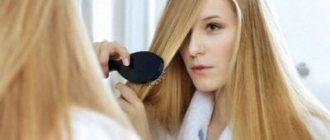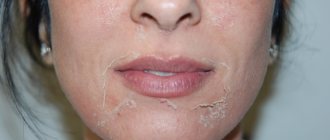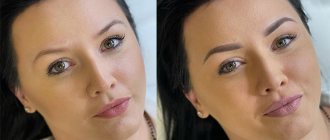PREFACE TO LASER GRINDING OF THE FACE
I came to the clinic with problems typical for my age - thinning of the skin, decreased elasticity and turgor, fine wrinkles, dull, unhealthy complexion, which I periodically “corrected” by visiting the solarium.
Frequent sunbathing naturally worsened the condition of the skin: the skin became even thinner, dryer, flabby, with reduced tone and a large number of fine wrinkles. In general, a vicious circle. Of course, when I was offered deep laser peeling (laser resurfacing), I was afraid. Is it conceivable to practically burn the skin on your face? On the forums I read about some kind of scabs, scars and other passions. But they explained everything to me in great detail, told me about the terms of rehabilitation and the expected effect. And so, I made up my mind and took a 2-week vacation from work.
Photo before surgery
It can be seen that the skin is very uneven and uneven in color. I had to constantly powder and brown.
Types of laser radiation
To remove acne scars with laser, four types of equipment with different radiations are used:
- Neodymium laser – has a fractional effect. The pulses penetrate to a depth of 4-6 mm. Allows you to treat acne and eliminate the spread of microorganisms that cause acne formation. After the procedure, you don’t have to hide from the sun. Can be used to correct any area - face, neck, décolleté, back.
- Erbium laser is a representative of traditional grinding. Helps remove scars and tattoos. Doesn't heat cells. Penetrates into deep layers, not recommended for use during periods of active sun. The device has a targeted effect. After the session, swelling and redness of the treated area is observed.
- Fraxel - has a targeted effect on cells, heating them from the inside. The surface layer is not injured, which significantly reduces the rehabilitation period. After the procedure, metabolism accelerates and natural collagen production is stimulated. Used to eliminate post-acne, vascular network, stretch marks and age spots.
- Multilaser – combines several technologies. Able to remove post-acne and existing inflammatory foci. There are no consequences after the procedure.
The doctor chooses the appropriate type of laser.
FIRST DAY AFTER LASER GRINDING OF THE FACE
As soon as I recovered from the anesthesia, I immediately began to look at myself in the mirror and take pictures with my phone. Under a thick layer of ointment there was a red, red face! The next day I felt a burning sensation and pain. They immediately gave me an anesthetic injection, in the evening I began to ache a little again and the injection was repeated. And so, everything was wonderful.
Photo after surgery
How it works
The essence of the procedure differs slightly depending on the chosen technique. The equipment is selected by a cosmetologist after collecting anamnesis and diagnosing the patient. Laser treatment can be non-ablative or ablative.
Non-ablative devices Fraxel or ResurFX M22 work more delicately compared to ablative equipment. The laser beam forms tiny perforations on the surface of the scar, surrounded by islands of intact tissue. In response to damage, the body triggers collagen synthesis, and young skin cells gradually replace scar formations. After several procedures, the scars soften and become elastic, acquire the color of healthy skin and normal texture.
The ablative effect on AcuPulse equipment is more intense and is indicated for deep and old scars. Laser beams penetrate deeply into tissues and cause active formation of collagen fibers. The wound surface requires careful care, so a rehabilitation period is necessary after the procedure.
FIRST WEEK AFTER LASER GRINDING OF THE FACE
They gave me painkillers, some other tablets, washed my face every 2 hours and applied magic ointments again, after which the discomfort and feeling of tightness immediately disappeared. This went on for three days. The only thing that annoyed me was the inability to wash myself! Only on the third day I was allowed to take a warm shower, avoiding my face and head.
On the fifth day after laser facial resurfacing, I was discharged. I looked like this:
At this point, brown crusts have appeared. I looked, of course, shocking, red face with brown spots. At home, I continued to wash and smear myself. Even a little more often than necessary, because cat hair was sticking to me.
Stages of the procedure
First, the doctor examines the client, assesses the size, type and age of the scar formation, selects equipment and treatment mode. The procedure requires preliminary preparation. For two weeks before the session, you should not sunbathe, do peeling or take photosensitizing drugs. The procedure begins by applying an anesthetic ointment to the treatment area, and after 40–60 minutes, cosmetic manipulations begin:
- a beam of light rays is directed to the problem area, which destroys the cells of scar formation;
- use cold blowing to eliminate discomfort for the patient;
- After manipulations with the AcuPulse ablative device, the doctor applies a healing ointment to the wound surface and, if necessary, applies a bandage.
After the session, redness appears at the site of the scar formation, as well as a crust that cannot be removed independently. After 6–7 days, the crust disappears, but for another 3–4 weeks the affected area is protected from ultraviolet radiation and protected from thermal and mechanical damage.
SECOND WEEK AFTER LASER GRINDING
On the seventh day after laser facial resurfacing, I came for an examination. By this time, almost all the brown spots had disappeared. My skin has turned pale, and now I blush only from time to time, from emotions.
Of course, my new skin has been very thin all month and needs to be handled delicately. As soon as you rubbed it accidentally, an abrasion or “hole” appeared.
Complications
Peeling is not a painful procedure. It is performed under local anesthesia: an anesthetic is applied to the skin. Cosmetologists introduce patients to predicted complications. What to expect after peeling?
- The skin turns red, like a sunburn.
- Skin dehydration occurs: the patient has a feeling of tightness on the face.
- There is severe swelling.
- On day 3, the skin begins to peel off: cosmetologists say that the process will stop in a week.
- The skin darkens: it goes away after a month.
If the skin is sensitive, then after the procedure melanin may be sharply produced: hyperpigmentation appears. Cosmetologists say that the process in some cases continues for a long time, up to a year. Some patients experience a rise in body temperature.
Unpredictable complications include an allergic reaction to a certain composition of the substance used in peeling. The procedure is stopped immediately.
THIRD WEEK AFTER LASER GRINDING OF THE FACE
After 2 weeks, acne appeared. I was warned of a possible exacerbation (in my youth I was tormented by acne), but I hoped that this would not affect me. I started applying Metrogyl, and in three days they went away without leaving any traces.
In addition to spots and pimples, it seemed that the whole face seemed to sag and periodically swell a little.
On examination on the 10th day after laser facial resurfacing
Removing age spots on the face
Types of pigmentation
Dermatologists identify dozens of types of age spots. The most famous and common are lentigo, ephelides, melasma, and birthmarks. Ephelides, also known as freckles, appear on the face at a young age in people with a hereditary predisposition and fair skin. The number of freckles and the intensity of their coloring increases in the warm season, when the skin of the face is exposed to solar ultraviolet radiation.
Lentigo is a small, limited pigment spot that forms in adulthood under the influence of ultraviolet radiation. This type of lentigo is usually called solar lentigo. Senile lentigo often develops in older people. There is also juvenile lentigo, which must be differentiated from ephelides.
Secondary hyperpigmentation develops after burns, pyoderma, neurodermatitis, eczema. Sometimes age spots appear at the site of secondary syphilis rashes. There are also rarer forms of pigmentation - Broca's pigmentary dermatosis, melasma, Dubreuil's melanosis (melanoma-dangerous).
Diagnostics
It is difficult to accurately determine the type of pigmentation; this task is best entrusted to a dermatologist. Although the removal of age spots is carried out using many techniques, and the type of pigmentation does not always matter, before starting therapy, a skin biopsy is performed to confirm the benignity of the formation.
Methods for removing age spots
There are a lot of ways to combat this cosmetic defect, but not all of them are effective. Traditional recipes, such as treating the problem area of the skin with lemon juice, olive oil or celandine, often provoke irritation and inflammation, but rarely bring the desired result. It is better to use pharmaceutical products that have passed clinical trials, or seek help from a cosmetologist.
Whitening creams
A popular remedy against age spots are various whitening creams. As a rule, such a product contains hydroquinone in a concentration of 4%. It may also contain tretinoin and other retinoids. Retinoids enhance exfoliation of the epidermis, but have virtually no effect on the pigment.
Important! When using bleaching products, you must protect your skin from UV exposure for three months. In countries with hot climates, you need to use a protective cream with SPF 50. For residents of Moscow and other northern regions of the Russian Federation, it is enough to apply cream with SPF 30 to the skin.
Chemical peeling
In a cosmetology clinic or aesthetic medicine center, chemical peels are often used to remove age spots. It should be said that this is far from the most progressive method of correcting the defect in question, but it can give positive results.
To combat increased pigmentation, retinoic peeling, alpha hydroxy acids, glycolic acid peeling, Jessner's combined solution (resorcinol + lactic acid + salicylic acid), trichloroacetic acid in a concentration of up to 35% are used. After the procedures, you should adhere to the above recommendation - protect the skin from UV exposure for three months. Of course, you cannot sunbathe in a solarium.
Cryotherapy
Applications of liquid nitrogen are a quick and inexpensive method of removing age spots. The procedure takes a minimum of time, since the application itself lasts about five seconds.
Injection techniques
The problem of pigmentation may be secondary, caused by a violation of the trophism of the dermis and the metabolic activity of cells. In such cases, the use of injection techniques aimed at comprehensive rejuvenation, renewal and self-healing of the skin is indicated. Plasma therapy has an excellent effect. A popular and affordable method of facial rejuvenation is biorevitalization.
Phototherapy, ELOS
Phototherapy and ELOS are similar procedures. Phototherapy is based on the action of pulsed light on the facial skin (do not confuse light with ultraviolet radiation), which destroys melanin. ELOS rejuvenation is based on a combination of electromagnetic and light radiation. ELOS technology is used not only for hair removal, but also to combat pigmentation.
